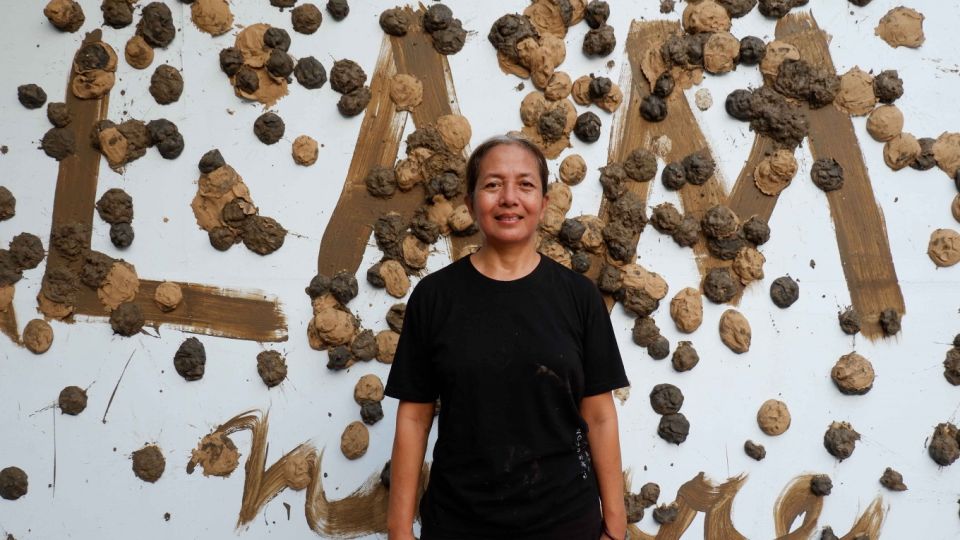February 8, 2022
JAKARTA – Bandung-born artist Arahmaiani is known for using her art and activism to fight for the environment, as well as in helping local communities to apply traditional methods and wisdoms to develop sustainable farms.
Reflecting on today’s environmental perils, renowned artist and environmental activist Arahmaiani persists in her criticisms of the government for its lack of action to protect and preserve the environment.
She has turned her fury into an art performance called Furious Mother Earth.
The performance begins with Arahmaiani writing the word “alam” (nature) in capital letters on a white wall as her audience sits beside a table covered with balls of clay. After she finishes writing, she picks up some of the clay balls and throws them at the wall. She then asks the audience to stand and throw the balls until the wall is spattered with clay.

Guilty by association: People throw balls of clay at a wall bearing the word “alam” in a performance of Arahmaiani’s interactive performance art, ‘Furious Mother Earth’. (JP/A. Kurniawan Ulung) (JP/A. Kurniawan Ulung)
The 20-minute performance art is Arahmaiani’s way of visualizing that nature is unwell from humans harming it constantly.
The 60-year-old artist blames humans for many “natural” disasters, including the COVID-19 pandemic.
“This pandemic is a sign from nature to us all that we have to change our mindset and way of life to prevent us from causing more destruction to this planet,” she said.
Government critic
In the national art scene, Arahmaiani is known for using her art to criticize religious intolerance and radicalism, as well as calling for interfaith dialogue and peace. However, her recent works mainly explore the relationship between nature and human activity that has led to environmental problems.
She used “furious” in the title of her latest performance art, she says, to “convey the message that Mother Earth is furious at us and we will suffer if we are not careful with our behavior toward nature”.
Before the pandemic, Arahmaiani was inspired by President Joko Widodo’s campaign promise to save the environment, which she believed remained unfulfilled. So she created a piece titled Shadow of the Past, which she performed at Museum Taman Prasasti in Central Jakarta, embracing trees while strolling the museum grounds, her face and hair covered with clay.
Arahmaiani often uses clay symbolically, because its base components of soil and water are the sources of all life.

Empty future: Arahmaiani, her face and head covered in clay, performs “Shadow of the Past” at Museum Taman Prasasti before the pandemic. The piece is a social commentary on President Joko Widodo’s unfulfilled campaign promise to protect the environment. (JP/A.Kurniawan Ulung)
Beyond art
Arahmaiani used to travel back and forth between Indonesia and Tibet, working with the monks there to initiate a tree-planting project while also working on her art projects.
Since the arrival of the pandemic and attendant travel restrictions, she has been focusing on developing organic farms in Bali and Yogyakarta.
In Yogyakarta, she has teamed up with santri (Islamic boarding school students) from Pondok Pesantren Amumarta in Bantul regency as well as residents and farmers of the Bumi Langit community, also in Bantul.
In Bali, she worked on various conversation projects in collaboration with the Sanggar Paripurna community in Bona village in Gianyar, and the Kebun Berdaya community in Tegeh Sari village, Denpasar.
The organic farms these communities designed inspired others in neighboring Balinese villages to follow suit. “The organic farms developed by the community in Bona are designed for rural people, while the organic farms developed by the community in Denpasar are designed for urbanites,” she explained.
Arahmaiani and the communities used permaculture to develop sustainable and self-sufficient agricultural ecosystems in alignment with local customs and wisdoms.
Permaculture adopts the natural arrangements of flourishing ecosystems in designing productive, self-sustaining human habitats, and is a movement founded by Australian researcher Bill Mollison.
According to Arahmaiani, however, ancestral Indonesians practiced the technique long before Mollison coined the term in 1978.
“In the past, people saw themselves as part of nature, not the ruler of nature. That’s why they had a harmonious relationship with nature. In contrast, people in the modern era tend to be destructive. Forests are cleared and natural resources like oil and coal are [taken] for money,” she said.

Ecological balance: Arahmaiani’s art since the pandemic has focused on the unbalanced, unharmonious relationship between nature and human beings that she believes is the root cause of natural disasters, including COVID-19. (JP/A. Kurniawan Ulung) (JP/A. Kurniawan Ulung)
Benefiting all
Balinese puppeteer I Made Sidia, who is also art director at the Sanggar Paripurna arts center in Gianyar, expressed his appreciation for Arahmaiani for helping his students to better understand nature and grow to love local traditions through her art.
He recalled Arahmaiani once performing one of her famous pieces, Flag Project, at Sanggar Paripurna and inviting his students to dance during the performance.
“This performance taught us to be open-minded, to love the noble values of our nation and most importantly, to care for the environment and fellow human beings,” said Made.
He also said Arahmaiani taught his students to grow vegetables and fruits using organic methods, splitting them into gardening groups with farming-inspired names like Kambing (Goat), Sapi (Cow), Anjing (Dog) and Ayam (Chicken) for a gardening competition at the arts center.
The competition helped the students understand the benefits of organic food and the dangers of pesticides to the human body, Made recounted.
“They don’t litter now. Before meeting Arahmaiani, they had no discipline in properly disposing garbage, particularly plastic waste. After her stay at Sanggar Paripurna, they had gained the self-awareness to do good for the environment,” he said.
Krisna Waworuntu, who runs an organic farm as part of the Bumi Langit community, said he was grateful for collaborating with Arahmaiani. “Our collaboration is not too artistic but functional, because I want its benefits to be sustainable for society and the environment,” he said.


